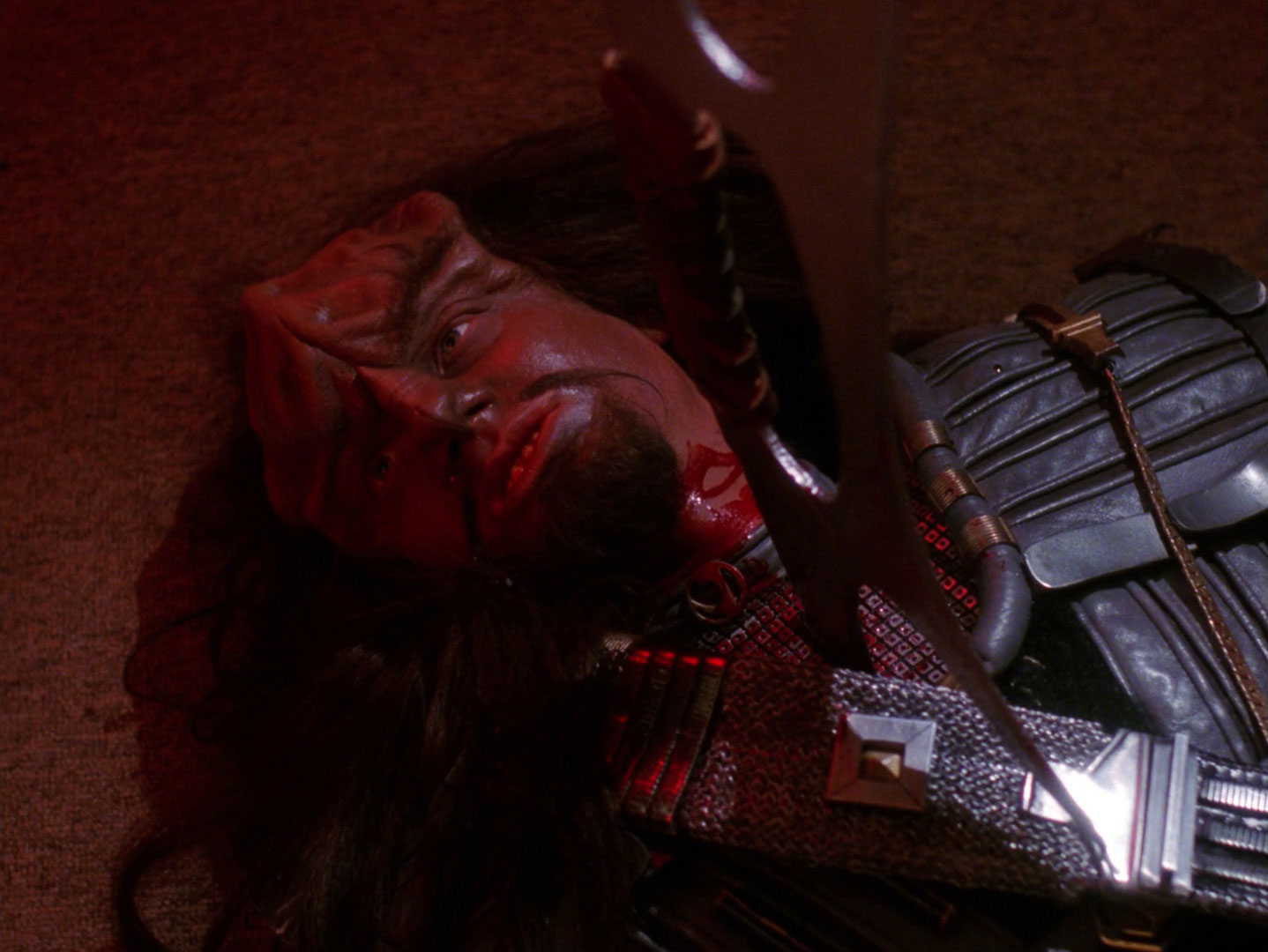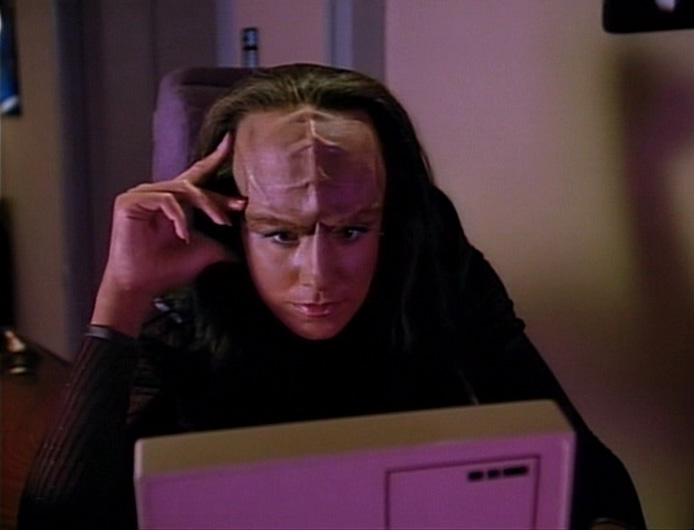
Our old buddy Ambassador K’Ehleyr (Suzie Plakson from “The Emissary”) shows up and Picard is forced to mediate the transfer of power within the Klingon Empire. High council leader K’mpec (Charles Cooper) is dying and Duras (Patrick Massett) and newly introduced Gowron (Robert O’Reilly) are the two guys vying for the spot. Of course, we all know from “Sins of the Father” that Duras is likely untrustworthy as his pops conspired with the Romulans back in the day and he and K’mpec conspired to blame it on Worf’s father. But Picard has to judge on the merits, and an unstated point is that it’s unknown if Gowron is any better. Turns out K’mpec was poisoned (he dies early in the episode) so the Enterprise crew must stop whoever did that from leading the empire. Meanwhile, K’Ehleyr brings with her Alexander (Jon Steuer), a small Klingon boy, and tells Worf that he’s a daddy (do Klingons smoke cigars?). Worf can’t acknowledge the connection because his dishonor would carry over to Alexander. K’Ehleyr, not buying Worf’s evasive answers, starts snooping around and figures out that Duras’s dad was the real traitor — in fact, Duras is conspiring with the Romulans in this episode — and Duras kills her when she confronts him. Worf claims the right of vengeance and kills Duras in some neato sword fighting. This, essentially, makes Gowron the new leader and gets Worf in some hot water with Picard. Worf then tells Alexander that he’s his father and sends him to live with his human parents.

Why it’s important
In what is essentially the sequel to “Sins of the Father” and “The Emissary”, we learn more about the power struggles within the Klingon Empire. That someone as obviously skeezy as Duras could be next in line is pretty terrifying and doesn’t speak well of the Klingon political system.
The political stuff surrounding Worf and Picard that started in “Sins of the Father” really continues here and continues through the rest of TNG (notably with the civil war in the “Redemption” two-parter) and into “Star Trek: Generations”, when Duras’s curvy sisters are essentially responsible for the destruction of the Enterprise-D. Well, that and Riker, Data, Worf and Geordi’s inability to make some pretty obvious tactical moves to defend the ship. Just wait until I review “Generations”. It’ll be one for the books, people.
The other thread involving K’Ehleyr is kind of a big deal. It’s a credit to TNG (to a point) that Alexander isn’t simply forgotten about after this episode. He ends up living on the Enterprise for good starting in about a year, after Worf’s human parents can’t handle him. Of course, it’s odd how little we see Alexander on the Enterprise AFTER that episode — like, why there weren’t TWO devolved (or as the episode calls them “de-evolved”) Klingon dinosaurs terrorizing the ship in “Genesis” — but oh, well.
The introduction of Gowron (and his relationship with Worf) is hugely important, as he’s a character we’ll see a lot of in TNG and DS9 going forward. He actually becomes more significant on DS9, as we’ll get to later.

What doesn’t hold up
The implication in this episode is that Alexander was spawned during “The Emissary”, about two years prior to this episode. If so, Klingon children don’t waste any time. He seems like he’s at least 3 or 4 here. A similar thing happens with Miles and Keiko O’Brien’s daughter Molly in TNG and DS9, as we’ll discuss later.
OTOH, Alexander could have been the result of Worf and K’Ehleyr’s prior relationship (they knew each other before “The Emissary”). But, then, he’d be like 7 or 8 — and it’s odd that K’Ehleyr didn’t bring him along or at least mention him in her previous appearance. Obviously, we could chalk the issue up to children of different species developing at different rates (or, some nonsense about Klingon years, or something). Or, we could just assume that a toddler seemed like the most dramatic/appropriate choice to the creators — like when the baby on “The Fresh Prince of bel Air” aged a few years in like one summer.
I guess the other thing that I struggle with is the idea that the Klingons even function as a society. That Klingon ship commanders can be executed by subordinates if they’re not hacking it is somewhat believable, because it’s a small scale. But we’re talking about the leadership of an entire empire that’s similar in size to the Federation. The treachery of Klingon leaders is something that will continue through DS9 — e.g. Gowron puts his own glory ahead of the interests of the empire during the Dominion War, something Worf says isn’t uncommon.
There are episodes later in TNG and DS9 in which the Klingons talk about how they’ve lost their way. But it doesn’t seem as if their way would have ever worked very well — or that what most concerns them is all the treachery. The schism between honorable warriors and the backroom dealings we routinely see is certainly interesting. But is is sustainable? I doubt it.
Lastly, it seems like this would be an obvious time when Picard’s assimilation would come up. K’mpec would have known what happened, considering the Klingons were sending ships to help fight the Borg. Why didn’t he say anything to Picard? “I see the Borg didn’t take away your warrior spirit, Captain.” Keep in mind that the Borg encounter happened since the last time K’mpec had any dealings with the Enterprise crew.
Oh, and lastly, lastly, the Klingon blood in this episode is very red — including from the (supposedly) fully Klingon, Duras. But, in “Star Trek VI: The Undiscovered Country”, we see a bunch of Klingon blood (like TONS of it) and it is very, very pink. Now, this episode was released before “Star Trek VI” — even though the events of the movie take place about 75 years before the events of this episode — and you could argue that the creators should be given a mulligan in “Reunion”. But Klingon blood in all episodes and movies after “Star Trek VI” is red, and not pink. Given how significant Klingon blood was in that film, not being consistent was really weak sauce. Keep in mind that Trek already went down this road and maintained continuity with Vulcan (and by extension Romulan) blood through TOS.
Final thoughts
This is actually a pretty nice episode. Picard’s unease about being in the middle of this Klingon nonsense works well. K’mpec plays the role of a master manipulator, and Picard rises to the challenge.
It’s also a pretty violent episode as TNG goes. We see the bat’leth for the first time and the super-cool Vor’cha class Klingon cruiser, too. The aftermath of Duras’s attack on K’Ehlyr is pretty bloody, as is the fight between Worf and Duras. That’s not a bad thing — it’s probably appropriate — but it is striking.
Coming later this week …
A prequel to “The Shawshank Redemption”. Don’t get the joke? How can you be so obtuse?
